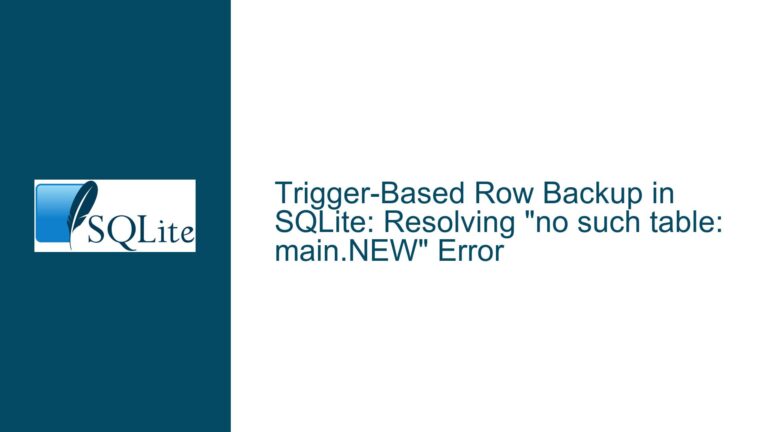Enhancing SQLite INSERT Statements with DEFAULT Values
Understanding the Need for DEFAULT in INSERT Statements
The ability to specify DEFAULT values within INSERT statements on a column level is a feature that many SQLite users have found themselves needing. This feature would allow for more flexible and efficient data insertion, particularly when dealing with tables that have numerous columns with default values. The core issue revolves around the desire to insert rows into a table where some columns should take their default values as defined in the table schema, while others are explicitly provided with values. This is particularly useful in scenarios where you want to insert multiple rows in a single statement, each with different combinations of default and explicit values.
Currently, SQLite requires that if a column is mentioned in the INSERT statement, a value must be provided for it. If no value is provided for a column, SQLite will use the default value defined in the table schema. However, there is no way to explicitly specify that a column should take its default value within the VALUES clause of an INSERT statement. This limitation can lead to verbose and repetitive code, especially when dealing with large tables or complex insertion logic.
For example, consider a table t1 with columns a, b, and c, each having default values:
CREATE TABLE t1 (
a INTEGER DEFAULT 1 NOT NULL,
b INTEGER DEFAULT 2 NOT NULL,
c INTEGER DEFAULT 3 NOT NULL
);
If you want to insert multiple rows where each row has a different combination of default and explicit values, you would need to write multiple INSERT statements:
INSERT INTO t1 (a) VALUES (10);
INSERT INTO t1 (b) VALUES (20);
INSERT INTO t1 (c) VALUES (30);
Alternatively, you could use the INSERT INTO t1 DEFAULT VALUES; statement, but this would insert a row where all columns take their default values, which is not always desirable.
The proposed feature would allow you to write a single INSERT statement that specifies which columns should take their default values and which should take explicit values:
INSERT INTO t1
(a , b , c ) VALUES
(10 , DEFAULT, DEFAULT),
(DEFAULT, 20 , DEFAULT),
(DEFAULT, DEFAULT, 30 );
This would insert three rows into the table, with each row having a different combination of default and explicit values.
Exploring the Technical Challenges and Constraints
The implementation of this feature in SQLite is not without its challenges. One of the primary technical hurdles is the way SQLite’s parser and execution engine handle INSERT statements. Currently, the parser expects a value for every column mentioned in the INSERT statement. Introducing the ability to specify DEFAULT values within the VALUES clause would require significant changes to the parser and the execution engine.
Another challenge is ensuring backward compatibility. SQLite is widely used in various applications, and any changes to its syntax or behavior must be carefully considered to avoid breaking existing code. The introduction of the DEFAULT keyword in the VALUES clause would need to be done in a way that does not conflict with existing SQLite syntax or behavior.
Furthermore, there is the issue of performance. Adding support for DEFAULT values in INSERT statements could potentially slow down the execution of INSERT statements, particularly if the feature requires additional checks or transformations during query execution. This is a concern for applications that rely on SQLite for high-performance data insertion.
Implementing and Testing the DEFAULT Feature in INSERT Statements
To implement the DEFAULT feature in INSERT statements, several steps need to be taken. First, the SQLite parser must be modified to recognize the DEFAULT keyword within the VALUES clause of an INSERT statement. This involves updating the grammar rules and ensuring that the parser can correctly interpret and validate the new syntax.
Next, the execution engine must be updated to handle the new syntax. When the DEFAULT keyword is encountered in the VALUES clause, the engine should use the default value defined in the table schema for the corresponding column. This requires changes to the code that processes INSERT statements and retrieves default values from the table schema.
Once the changes to the parser and execution engine are complete, thorough testing is essential to ensure that the new feature works as expected and does not introduce any regressions. This includes testing various scenarios, such as inserting rows with different combinations of default and explicit values, inserting rows into tables with different types of default values (e.g., constants, expressions, and functions), and ensuring that the feature works correctly with other SQLite features, such as transactions and triggers.
In addition to functional testing, performance testing is crucial to ensure that the new feature does not significantly impact the performance of INSERT statements. This involves benchmarking the execution time of INSERT statements with and without the DEFAULT keyword and comparing the results to identify any potential performance bottlenecks.
Finally, documentation must be updated to reflect the new feature. This includes adding examples and explanations to the SQLite documentation, as well as updating any relevant tutorials or guides. Clear and comprehensive documentation is essential to help users understand and effectively use the new feature.
Conclusion
The ability to specify DEFAULT values within INSERT statements is a valuable feature that can simplify and streamline data insertion in SQLite. While there are technical challenges and constraints to consider, the benefits of this feature make it a worthwhile addition to SQLite’s capabilities. By carefully implementing and testing the feature, SQLite can continue to evolve and meet the needs of its users, providing a powerful and flexible tool for managing data.






